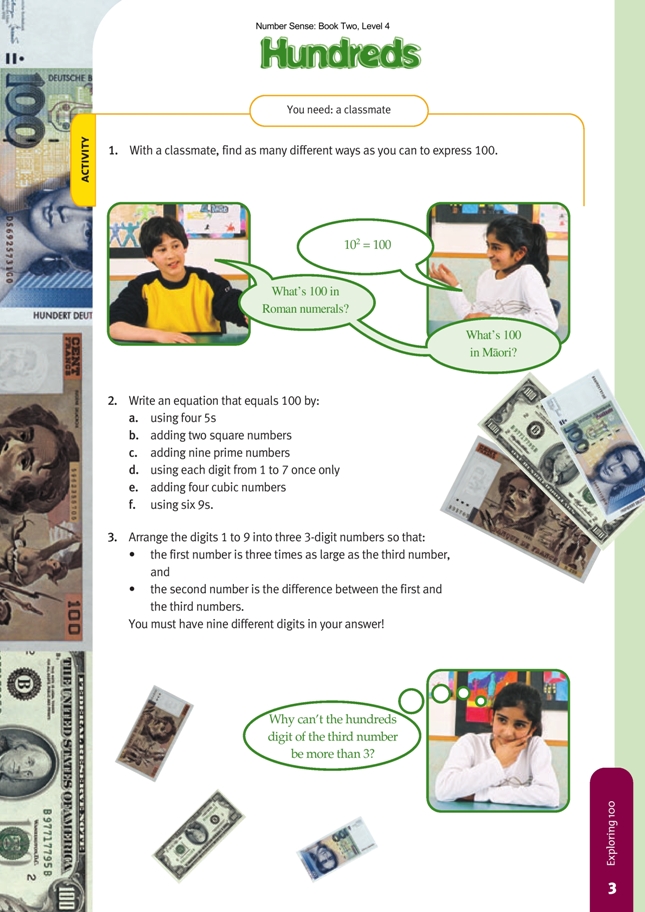This is a level 5 number activity from the Figure It Out series. It relates to Stage 8 of the Number Framework.
A PDF of the student activity is included.
Click on the image to enlarge it. Click again to close. Download PDF (688 KB)
explore squares, primes and cubics
A classmate
In the first question, you can help the students to realise that a number can have many names, in fact, an infinite number of names. For example, 100 (assuming that it is in the usual base 10) can be named using any of the four operation signs: 70 + 30, 120 – 20, 2.5 x 40, 500 ÷ 5, and 50 ÷ 0.5 are all names for 100. The students may accept the challenge of coming up with the most complex name for 100 that they can think of. They could add to the challenge by deciding that a number can be used at most once in an equation (this prevents equations such as 100 + 10 – 20 – 10 + 20 = 100, and so on).
A further extension of this first question would be to investigate how other cultures have represented 100. For example, the early Romans used the letter “C”, the Egyptians used a symbol that is similar to our lower-case “e”, and the Attic Greeks used a large “X”.
The second question requires students either to have or to gain an understanding of square numbers (for example, 6 x 6 = 62), cubic numbers (for example, 2 x 2 x 2 = 23), and prime numbers (that is, numbers that have only themselves and 1 as factors, such as 11 and 19). The students will also need to realise that when building equations:
• they can use any of the operations;
• they may need to use brackets (in question 2a, for example);
• they could consider the possibility of constructing fractions (for instance, in question 2f).
For question 2c, students who find different solutions could share them with the class. It would be interesting to challenge the class to devise at least three different solutions. Apart from the strategies just mentioned, it will be a matter of the students devising their own strategies to work out solutions to question 2. Sharing their
strategies would also be valuable, even if some were not able to solve a particular problem.
Question 3 is also likely to be a challenge. As with question 2d, more than one solution is possible. Encourage the students to come up with a strategy (or strategies) to solve the problem rather than simply guessing and checking a string of possible solutions. If, after a time, they are still struggling, you could suggest the strategy
outlined in the Answers. This still leaves the students with a lot of investigating to do to produce three different 3-digit numbers, using the digits 1–9 once only, that meet the other conditions of the problem.
In questions 2 and 3, a calculator is invaluable as a “number cruncher”. It enables the students to focus on problem solving rather than on tedious calculation. However, there are some problems in question 2 that the students can probably solve more quickly without the use of a calculator (for example, 2a, 2b, and 2f).
Answers to Activity
1. Expressions will vary. For example, 10 x 10, 102, a century, C (Roman), rau (Māori), and so on. You could also use number expressions such as 2 x 50,
60 + 40, 200 ÷ 2, 120 – 20, and so on.
2. a. (5 + 5) x (5 + 5) = 100
b. 36 + 64 = 100 (that is, 62 + 82 = 100)
c. 2 + 3 + 5 + 7 + 11 + 13 + 17 + 19 + 23 = 100
d. Solutions will vary. Possible answers include:
1 + 2 + 34 + 56 + 7 = 100
21 + 63 + 4 + 5 + 7 = 100
and 34 + 7 + 6 + 5 + 2 – 1 = 100
e. 13 + 23 + 33 + 43 = 100
f. 99 + 99/99 = 100
3. Answers may vary. A possible strategy could be:
Take a 3-digit number and multiply it by 3. If the product contains three new digits (you’ll need nine different digits altogether), subtract your original number from this product. If this product contains the remaining unused digits, you have
found three 3-digit numbers for your solution.
Two possible solutions are: 657, 438, and 219; 981, 654, and 327.
